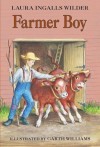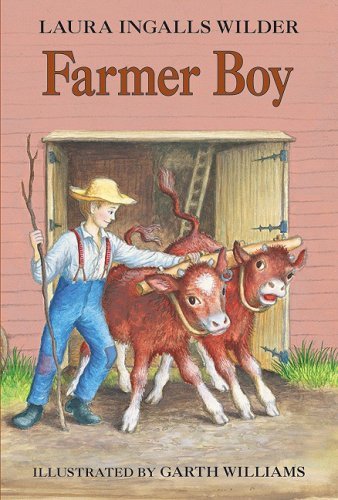 The Plot
The Plot
The Wilder family are prosperous farmers living in upstate New York in the middle of the 19th century. Almanzo, the youngest of the four Wilder siblings, is eager to be considered responsible enough to handle training the horses he adores. In the meantime though, there are plenty of things for a boy growing up on a working farm to learn and do. Even if that sometimes includes actually going to school.
My Thoughts
Farmer Boy opens in the winter, with the four Wilder children in the midst of the winter school term. The four are quite close in age, the eldest, Royal, being 13ish and the youngest, Almanzo, only a few weeks shy of nine. But in spite of the fact that he’s only a little bit younger than his next oldest sibling, Almanzo very much occupies the position of family baby, being indulged by his parents and bossed by the older children.
We follow Almanzo, and to a lesser extent all of the Wilders, over the course of slightly more than a year. The book strives to present in detail the various tasks (and pleasures) of a child growing up on a successful farm in New York state. To this end, though the narrative covers most of two winters, we really only see each task once, even though surely things such as timber hauling were a yearly chore. Perhaps one is meant to conclude that the first winter, Almanzo wasn’t involved due to his age (and the fact that Royal was at home to provide more competent help.)
Since Almanzo is a boy (and because the rest of the books focus so much on the tasks of women, being about Laura), Farmer Boy keeps its focus on the male sphere of farm work, with only brief glimpses now and then into the tasks which occupy the time and energy of Almanzo’s mother (and sisters). The women aren’t ignored or unacknowledged so much as their occupations just aren’t part of the list of skills that Almanzo is expected to acquire. It’s made abundantly clear that the talents of both Mr and Mrs. Wilder are essential to the smooth running of the farm and the family.
The book ends with Almanzo tacitly deciding he wants to be a farmer when he grows up, rather than a tradesman. He wins his parents’ approval as well as the chance to help train a young horse, something he’s been clamoring to do for years.
When I was younger, I was always annoyed when I came to Farmer Boy in the series. I had the box set in which Farmer Boy (in spite of being published second) was number 3. So I’d have been reading right along about Laura and her family and then, after being left at a surprising near cliffhanger at the end of book 2, I’d have to suddenly shift gears to New York and Almanzo’s well-to-do family. It really interrupted the flow of the narrative.
I still think it does, but I’ve solved the problem by reading it before the Laura books — since chronologically it would be ahead of them all, given Almanzo’s age. It’s not entirely clear if that’s still the case within the timeline of the books; the Wilders, even more than the Ingalls, have been tinkered with for the purposes of the books. Almanzo’s oldest sister is omitted entirely, perhaps due to her misfortune in also being named Laura, and the other extant siblings (his youngest brother wouldn’t have been born yet during the time period covered by Farmer Boy) have had their ages compressed quite a bit to make them closer together.
But how well the characters match up to their real life counterparts is irrelevant, since this is historical fiction, not a history. And it really is fabulous historical fiction. Now, more than 80 years after the story was originally written, we’re even further removed from the time period Laura Ingalls Wilder was trying to capture. But the level of detail she provides about the small things — the way the yoke attached to the oxen, or the way they loaded logs onto the sleds — makes it possible to imagine the scene even without much knowledge of 19th century farming.
I find Farmer Boy interesting for a number of other reasons as well. Geographically, it takes place in a part of New York I’m not super familiar with. Malone, the town nearest the Wilder farm, is very far upstate, mere miles from Quebec. It’s not stated in the text, but the presence of ‘French’ people nearby is probably the result of the non-border we shared with Canada at the time. (It wasn’t until after 1906 that anyone even bothered to start keeping track of Canadians entering the US.) Their portrayal plays to a popular stereotype of French-Canadians at the time (see: the works of L.M. Montgomery) the origins of which I don’t really know, but which interests me as someone with a significant amount of Québécois ancestry.
But even more than interesting historical sidetracks, what’s most compelling about Farmer Boy is the FOOD. It’s dangerous to read this book while hungry; the loving descriptions of the heaps of food eaten by the Wilder family make it extremely difficult to resist getting something to eat. Popcorn, cider, ice cream, ham, pancakes, potatoes, goose, gravy, sausage, maple syrup, bread, lemonade, egg nog, pies of all types: mealtime is the most frequent scene and it always leaves me desperately wanting to pig out.
In Short
Farmer Boy is unique among the Little House series: it’s the only book with a male main character. This holds true even taking into account the large extended series — the prequels and sequels authored by others. As such, though Almanzo and some of his relatives appear again in the later books, this one about his childhood is really very much stand alone. But it’s fascinating anyway — especially as the Wilders lived not too far from where some of my own ancestors were during that time period — and highlights very well the big difference between Almanzo’s early life and Laura’s.

